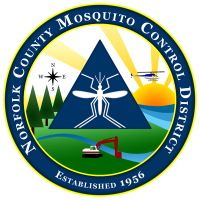What are Larvicides?
Larvicides kill mosquito larvae. Larvicides include biological insecticides, such as the microbial larvicides Bacillus sphaericus and Bacillus thuringiensis israelensis. Larvicides include other pesticides, such as temephos, methoprene, oils, and monomolecular films. Larvicide treatment of breeding habitats help reduce the adult mosquito population in nearby areas.
How Are They Used?
State and local agencies in charge of mosquito control typically employ a variety of techniques in an Integrated Pest Management (IPM) program. An IPM approach includes surveillance, source reduction, larviciding and adulticiding to control mosquito populations. Since mosquitoes must have water to breed, source reduction can be as simple as turning over trapped water in a container to undertaking large-scale engineering and management of marsh water levels. Larviciding involves applying pesticides to breeding habitats to kill mosquito larvae. Larviciding can reduce overall pesticide usage in a control program. Killing mosquito larvae before they emerge as adults can reduce or eliminate the need for ground or aerial application of pesticides to kill adult mosquitoes.
What are Microbial Larvicides?
Microbial larvicides are bacteria that are registered as pesticides for control of mosquito larvae in outdoor areas such as irrigation ditches, flood water, standing ponds, woodland pools, pastures, tidal water, fresh or saltwater marshes, and storm water retention areas. Duration of effectiveness depends primarily on the mosquito species, the environmental conditions, the formulation of the product, and water quality. Microbial larvicides may be used along with other mosquito control measures in an IPM program. The microbial larvicides used for mosquito control are Bacillus thuringiensis israelensis (Bti) and Bacillus sphaericus (B. sphaericus).
Bacillus thuringiensis israelensis is a naturally occurring soil bacterium registered for control of mosquito larvae. Bti was first registered by EPA as an insecticide in 1983. Mosquito larvae eat the Bti product that is made up of the dormant spore form of the bacterium and an associated pure toxin. The toxin disrupts the gut in the mosquito by binding to receptor cells present in insects, but not in mammals. There are 26 Bti products registered for use in the United States. Aquabac, Teknar, Vectobac, and LarvX are examples of common trade names for the mosquito control products.
Bacillus sphaericus is a naturally occurring bacterium that is found throughout the world. B. sphaericus was initially registered by EPA in 1991 for use against various kinds of mosquito larvae. Mosquito larvae ingest the bacteria, and as with Bti, the toxin disrupts the gut in the mosquito by binding to receptor cells present in insects but not in mammals. VectoLex CG and WDG are registered B. sphaericus products and are effective for approximately one to four weeks after application.
Do They Pose Risks to Human Health?
The microbial pesticides have undergone extensive testing prior to registration. They are essentially nontoxic to humans, so there are no concerns for human health effects with Bti or B. sphaericus when they are used according to label directions.
Do They Pose Risks to Wildlife or the Environment?
Extensive testing shows that microbial larvicides do not pose risks to wildlife, nontarget species, or the environment, when used according to label directions.
What is Methoprene?
Methoprene is a compound first registered by EPA in 1975 that mimics the action of an insect growth-regulating hormone and prevents the normal maturation of insect larvae. It is applied to water to kill mosquito larvae, and it may be used along with other mosquito control measures in an IPM program. Altosid is the name of the methoprene product used in mosquito control and is applied as briquets (similar in form to charcoal briquets), pellets, sand granules, and liquids. The liquid and pelletized formulations can be applied by helicopter and fixed-wing aircraft.
Does Methoprene Pose Risks to Human Health?
Methoprene, used for mosquito control according to its label directions, does not pose unreasonable risks to human health. In addition to posing low toxicity to mammals, there is little opportunity for human exposure, since the material is applied directly to ditches, ponds, marshes, or flooded areas that are not drinking water sources.
Does Methoprene Pose Risks to Wildlife or the Environment?
Methoprene used in mosquito control programs does not pose unreasonable risks to wildlife or the environment. Toxicity of methoprene to birds and fish is low, and it is nontoxic to bees. Methoprene breaks down quickly in water and soil and will not leach into ground water. Methoprene mosquito control products present minimal acute and chronic risk to freshwater fish, freshwater invertebrates, and estuarine species.

